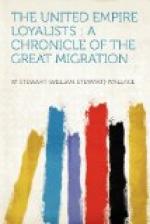At the end of July Governor Parr paid the town a visit, and christened it, curiously enough, with the name of Shelburne, after the British statesman who was responsible for the Peace of Versailles. The occasion was one of great ceremony. His Excellency, as he landed from the sloop Sophie, was saluted by the booming of cannon from the ships and from the shore. He proceeded up the main street, through a lane of armed men. At the place appointed for his reception he was met by the magistrates and principal citizens, and presented with an address. In the evening there was a dinner given by Captain Mowat on board the Sophie; and the next evening there was another dinner at the house of Justice Robertson, followed by a ball given by the citizens, which was ’conducted with the greatest festivity and decorum,’ and ’did not break up till five the next morning.’ Parr was delighted with Shelburne, and wrote to Sir Guy Carleton, ’From every appearance I have not a doubt but that it will in a short time become the most flourishing Town for trade of any in this part of the world, and the country will for agriculture.’
For a few years it looked as though Shelburne was not going to belie these hopes. The autumn of 1783 brought a considerable increase to its population; and in 1784 it seems to have numbered no less than ten thousand souls, including the suburb of Burchtown, in which most of the negro refugees in New York had been settled. It became a place of business and fashion. There was for a time an extensive trade in fish and lumber with Great Britain and the West Indies. Ship-yards were built, from which was launched the first ship built in Nova Scotia after the British occupation. Shops, taverns, churches, coffee-houses, sprang up. At one time no less than three newspapers were published in the town. The military were stationed there, and on summer evenings the military band played on the promenade near the bridge. On election day the main street was so crowded that ’one might have walked on the heads of the people.’
Then Shelburne fell into decay. It appeared that the region was ill-suited for farming and grazing, and was not capable of supporting so large a population. The whale fishery which the Shelburne merchants had established in Brazilian waters proved a failure. The regulations of the Navigation Acts thwarted their attempts to set up a coasting trade. Failure dogged all their enterprises, and soon the glory of Shelburne departed. It became like a city of the dead. ‘The houses,’ wrote Haliburton, ’were still standing though untenanted: It had all the stillness and quiet of a moonlight scene. It was difficult to imagine it was deserted. The idea of repose more readily suggested itself than decay. All was new and recent. Seclusion, and not death or removal, appeared to be the cause of the absence of inhabitants.’ The same eye-witness of Shelburne’s ruin described the town later:




